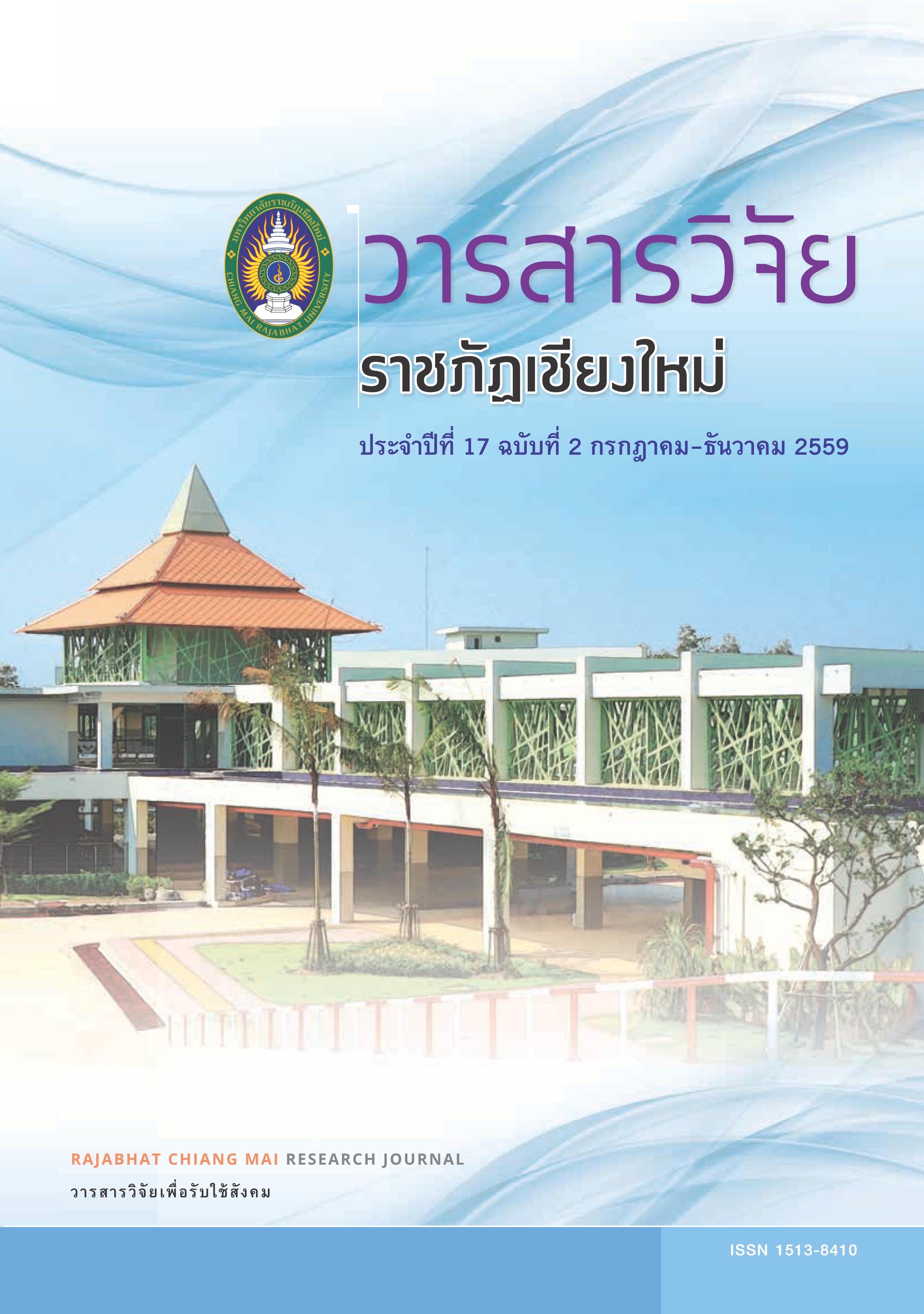The Development of Education Model by Sub-District Non-Formal Education for Developing the Aging Quality of Life Sub-Urban Areas in Chiang Mai Province Sub-Urban areas
DOI:
https://doi.org/10.14456/rcmrj.2016.213901Keywords:
Education Model, Non-Formal Education, teachers in Sub-district level, Aging, Quality of Life, Sub-Urban AreasAbstract
The purposes of this research aimed to 1) develop Education Model by sub-district Non-formal Education in order to improve quality of life for aging in sub urban area in Chiang Mai. 2) develop Non-formal Education teachers in sub-district level in terms of knowledge, attitude and behavior/practice in educational management in order to improving quality of life for aging in sub-district level. 3) test and compare the evaluation’s results of aging in experimental group and controlling group in Hang dong sub-district in term of knowledge, attitude and behavior/practice in order to improving quality of life for aging in sub urban area in Chiang Mai.
The researcher divided the research into 2 periods, the first one, was the study of contents, frameworks, related theories and case studies concerning sub-district Non-Formal Education which were successful in term of learning management for improving the quality of life of aging. The researcher collected the data by using in-depth interview from 15 people; the directors of Non-formal Education centers in district level, mayors of sub-district municipality, teachers, and local welfare support officers in Sub-district administrative organizations. The researcher also collected the data from 60 people by focus group. Then the researcher analyzed the results and developed those results to design the Development of the Education Model focus on the improving quality of life of aging and to develop the training course curriculum for teachers in Non-formal education in Sub-district level. The research results showed that education model were Sub-district Non-Formal Education, target of the Aging, networks, structure of working for district and sub-district levels, budget, curriculum model of project/activities, and indicators of the aging quality of life. The second period of the research were quasi experimental design: 1) the designing of teacher training courses for 2 teachers in experiment group by giving basic knowledge of aging, field trips, provide training with health professionals aging, the facilitator, practice in the real situations and handbook for teachers in order to improving the quality of life for the aging. The statistics were published as percentage scores, mean scores and compared between pre-test and post-test. The result showed that the teachers had higher mean scores in terms of knowledge, attitude and behavior/practice than before training. 2) Test and compare the evaluation’s results of aging in experimental group and controlling group in Hang dong sub-district in term of learning management for improving quality of life of aging. The researcher experimented by using the Development of Education Model which has been developed for the aging in sub-district Non-formal Education. There were in total 115 people in experimental group and controlling group. The statistics were published as percentage scores, mean scores, standard deviation scores, and t-test scores. The result showed that both experimental group and controlling group were not different in term of knowledge, before they involved the Education Model. The mean scores of Attitude and behavior/practice aspect were different. However, after they participated in Education Model. The researcher found that the aging in experimental groups had higher mean scores in terms of knowledge, attitude, and behavior/practice than pre experiment and higher mean scores in terms of knowledge, attitude and behavior/practice than the controlling groups who were not participated in.
Downloads
References
ประนอม โอทกานนท์ และคณะ. (ม.ป.ป.). การพัฒนาหลักสูตรอบรมทักษะการจัดการความรู้ ด้านการสร้างเสริมสุขภาพสำหรับผู้สูงอายุ. รายงานวิจัยคณะพยาบาลศาสตร์ มหาวิทยาลัยบูรพา จังหวัดชลบุรี.
ระวี สัจจโสภณ. (2553). แนวคิดทางการศึกษาเพื่อพัฒนาภาวะพฤติพลังในผู้สูงอายุ. วิทยานิพนธ์ครุศาสตรดุษฎีบัณฑิต สาขาวิชาการศึกษานอกระบบโรงเรียน จุฬาลงกรณ์มหาวิทยาลัย.
ศศิพัฒน์ ยอดเพชร. (2549). แนวทางการจัดบริการสวัสดิการสำหรับผู้สูงอายุ. กรุงเทพฯ: สถาบันไทยคดีศึกษา มหาวิทยาลัยธรรมศาสตร์.
สมศักดิ์ ชุณหรัศมิ์. (2555). การพัฒนาคุณภาพชีวิตของผู้สูงอายุ พัฒนาพื้นที่ต้นแบบและปัจจัยสำคัญ กรุงเทพฯ: มูลนิธิสถาบันวิจัยและพัฒนาผู้สูงอายุไทย.
สำนักงานการศึกษานอกระบบและการศึกษาตามอัธยาศัย. (ม.ป.ป.). การศึกษานอกระบบและการศึกษาตามอัธยาศัยในปัจจุบัน. (ระบบออนไลน์). แหล่งข้อมูล: https://panchalee.wordpress.com /2010/12/21/nfe_ac1/ (15 มกราคม 2558)
อาชัญญา รัตนอุบล และคณะ. (2555). การพัฒนาแนวทางการส่งเสริมการจัดการศึกษา/การเรียนรู้เพื่อพัฒนาศักยภาพผู้สูงอายุ. วารสารครุศาสตร์. 40(1): 14-28.
Downloads
Published
How to Cite
Issue
Section
License
1. Articles, information, content, images, etc published in the “Community and Social Development Journal” are copyrighted by the Community and Social Development Journal, Chiang Mai Rajabhat University. In order to properly distribute the articles through print and electronic media, the authors still hold the copyright for the published articles under the Creative Commons Attribution (CC BY) license, which allows the re-distribution of the articles in other sources. References must be made to the articles in the journal. The authors are responsible for requesting permission to reproduce copyrighted content from other sources.
2. The content of the articles appearing in the journal is the direct responsibility of the article authors. The editorial board of the journal does not necessarily agree with or share any responsibility.














